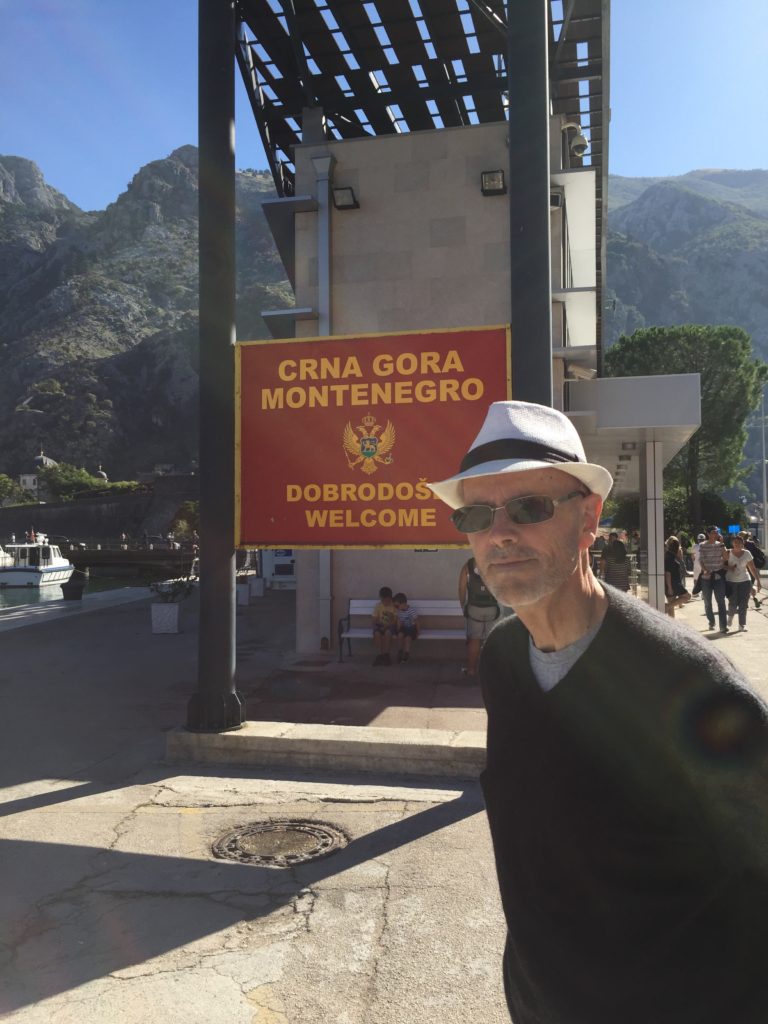
The world is full of weird little places. Just have to go out and look around a bit, and you will find one.
Such as Kotor, a walled city of 13,000 people in the Republic of Montenegro, which has been independent only since 2006 — and which I can add to the list of Nations I Have Visited.
From Dubrovnik, a Croatian town with lots of character, we floated down the Adriatic to Kotor, a Montenegrin town with … lots of character, but not refined to occasional boredom, as is the case in Dubrovnik.
Kotor is surrounded by mountains, and is at the end of a winding channel of seawater that bores deep into the hills and provides some fine places to fish or sail or build a walled city.
It also is a very good place to invite stray cats to become semi-members of the family. But more on that in a moment.
Like many towns and cities in the Balkans, Kotor has a lot of history. Too much, in fact.
History tends to attach itself to wars, floods, fires and other exotic events, and Kotor has a lot of it, going back to the Roman Empire, when it was part of the province of Illyria.
After the western Roman Empire collapsed, in the late 5th century, Kotor became a plaything of a town, a bauble for bigger powers to toss around. That led to time under the Ostrogoths, the Byzantines, the Venetians, the Serbs, etc., etc., and even the Ottoman Turks for some unpleasant interludes.
The Venetians pretty much ran Kotor for four centuries, and it was their construction of defensive works and the erection of stone houses that stuck, branding it as a Venetian possession at a key time in its history.
Kotor is a fine example of what a medieval Balkan city would like look, if it hadn’t been pulled apart, as most medieval Balkan towns have been, because of subsequent development.
Narrow paths opening into bigger squares, little houses up steep stairs, battlements atop the walls and churches all over, Roman Catholic, Russian Orthodox and Oriental Orthodox.
Oh, and ships of all shapes and sizes plying the Mediterranean to the greater glory and financial advancement of overlords, especially Venetian ones.
Eventually, Kotor became part of Serbia, and then Yugoslavia under the name of “Montenegro” and went through two world wars. In each war they were mostly subdued by the German-led invaders, then bouncing back to the winning side in the end.
Kotor is based on a defensible naval position, so it had military value, especially when various states were waging commercial (and sometimes shooting) wars on the Adriatic.
At least two submarine pens still exist, hacked out of the mountains between Kotor and the Adriatic, and they make for some interesting swimming — about 250 yards in what was a German pen during World War II, and about 125 yards in what was a Yugoslav pen during the Cold War.
The subs are gone, and so are the soldiers and sailors, but the pens still exist, and some people on our cruise ship went over there to swim in the unusually warm and clear water.
Meanwhile others of us went ashore at the town — in lifeboats, because Kotor has only one dock remotely big enough to handle a cruise ship, and it was already occupied.
Which was fine. The lifeboats put us at the old gate to the city, and we spent an hour or two admiring little ceramics, looking at T-shirt shops and trying to stay out of the way of tour groups from the pair of monster ships anchored in front of the town.
We also found some fun Christmas ornaments.
Eventually, we found a promising place to eat lunch.
“Eating lunch in foreign towns” is a leading form of entertainment for one of our fellow travelers, and this foreign lunch turned out unusually well.
We were the first customers in the place, which is worrisome, but it later filled up, and for good reason. It was really good. Especially the shrimp risotto and the two portions of bruschetta with sheep cheese and soft but firm bread perfect for delivering to the mouth plenty of white cheese and diced tomatoes.
OK, the cats.
Kotor is known for its cats. It may have more art devoted to the images of cats than any city in the world, on a per-capita bases. Plenty of live cats are there, too, underfoot, waiting impatiently to be fed and watered by townsfolk. We are told: “The city has several cat stores and a cat museum, as well as the Cats’ Square.”
The cats are more decorative than cuddly.
Actually, I would call them a menace became some of them are semi-feral, or seriously feral. A relative once stopped here (what are the odds?) and touched a Kotor street cat, which awarded her with a bloody bite that required four rounds of vaccinations against rabies.
We ambled out of the town, talking again about how weird it must be for these small places to look up and see two (or more?) monstrous ships out on the water, about to set loose a couple of thousand invaders on their narrow streets. The crowds!
The money!

0 responses so far ↓
There are no comments yet...Kick things off by filling out the form below.
Leave a Comment